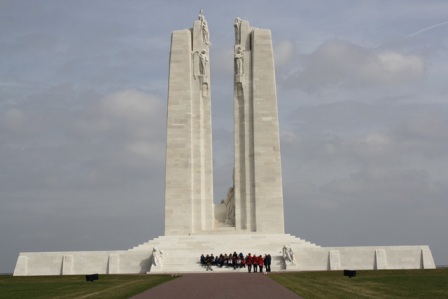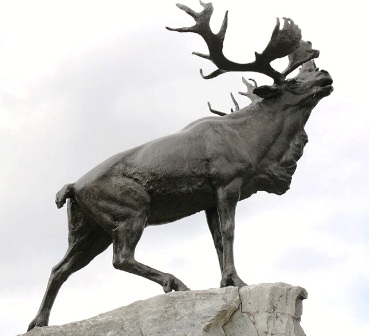
Click here to read Part 2: Ieper (Ypres) Belgium
|
Tuesday 23 March 2010 It is a chilly, overcast day in Northern France. Ray and I drive into a forested park and pass a jogger and several people with dogs along the walking paths next to the road. This looks good. But wait, the woods are full of strange grassy bumps and there are signs at the edge of the forest warning not to stray into the woods as there may be unexploded artillery. This sounds very ominous. This is the Vimy Ridge Memorial park, 250 acres (107 hectares) of a preserved WWI battlefield, reforested with over 3,500 trees, one for every Canadian soldier killed on April 9, 1917. It seems incredible that so many lives were lost in a single battle. And that was not the only time so many lives were lost. We were to discover that young lives were ended in record numbers throught the four years of WWI. Our friend Dawn Logan attended theVimy Ridge Memorial rededication ceremony on 9 April 2007, the 90th Anniversary of the battle to take Hill 145. She spoke in glowing terms of her trip to the ceremony and visits to the many WWI Memorials and Cemetaries in this area. Ray suggested we make a trip to Vimy on one our trips to Paris. The time was right this year so we took a few days away from visiting our grandchildren in Paris and to drive north to find out more about Canada's role in WWI. We learned far more than we expected and came away impressed by the care and reverence shown for the many commemorative sites in the area by the Canadian, French, British and Belgian Governments. Ray found a very helpful and informative website about visiting Vimy Ridge, written by John Stephens of Brampton, Ontario with scads of background info and links to more background information. We followed his suggestions to visit several sites in France and Belgium as well as the Vimy Memorial. See www.thegreatwar.ca for "A Canadian's Visit to Vimy Ridge and WWI Battlefields of Flanders" Ray suggested that a Memorial to Newfoundland was on the way to Vimy and would make a good first stop. The memorial near the town of Beaumont-Hamel, was less than a two hour drive on the A1 expressway NE of Paris, France. Both Beaumont-Hamel and Vimy Ridge are National Historic Sites of Canada and cared for by Veterans Affairs Canada. Canadian University students are chosen as guides for both sites. They are on four month terms, learning the history of WWI and doing a great job of imparting that knowledge to the many visitors to the sites. We had fun talking to them and finding out where they were from. It was obvious to us that the students felt priveledged to be chosen as guides.  The first thing you see when you reach Beaumont-Hamel is a bronze
cariboo standing atop a rocky mound. Newfoundlanders rallied after WWI
to raise money to create the memorial. A 74 acre (28 hectares) preserved
battlefield park was opened in 1925 marking the spot where
a Newfoundland regiment fought alongside British and French forces to
scrape out a victory on 1 July 1916, the first day of the Battle of the
Somme. It was one of the bloodiest battles of WW1. A total of 57,000
soldiers were killed in a single day. Contrary to what the regiments had
been told, German artillery was not silenced and barbed wire had not
been removed. The Newfoundland regiment was almost wiped out. Of 809
Newfoundlanders, only 68 were able to answer the call the next day. The first thing you see when you reach Beaumont-Hamel is a bronze
cariboo standing atop a rocky mound. Newfoundlanders rallied after WWI
to raise money to create the memorial. A 74 acre (28 hectares) preserved
battlefield park was opened in 1925 marking the spot where
a Newfoundland regiment fought alongside British and French forces to
scrape out a victory on 1 July 1916, the first day of the Battle of the
Somme. It was one of the bloodiest battles of WW1. A total of 57,000
soldiers were killed in a single day. Contrary to what the regiments had
been told, German artillery was not silenced and barbed wire had not
been removed. The Newfoundland regiment was almost wiped out. Of 809
Newfoundlanders, only 68 were able to answer the call the next day.
We followed well kept paths to visit all of the site, which includes three cemetaries and several other memorials to the combined forces. The original battlefield has been preserved complete with original artillery craters and trenches. Grass has grown over the once muddy field but it cannot disguise the devestation left by the battles. It wasn't difficult to image the horrific conditions facing the soldiers that day. We spent the night at a very good Bed and Breakfast in Thelus, a small town outside Arras, where the student guides stay. It was just a 10 minute drive the next day to the Vimy Ridge Memorial, where we took advantage of an excellent free guided visit to a section of the original trenches and underground subways and tunnels. We shared part of the tour with a group of British students, all there to see the battlegrounds they study as part of their curriculum. On April 9, 1917, all four Canadians Battalions fought together for the first time, aided by British troops. The planning by the two Canadian Generals, Currie and Byng made a difference. This time preparations for the battle were properly made and weaponry had improved but there was still a huge loss of life. The victory at Vimy was significant for Canada. It has been said that Canada went into WWI as a colony of Britain and came out a nation. After finished our tour we learned more about WWI in the well run Visitors Center. Only then were we ready for the Vimy Memorial itself. A design contest was held in Canada and Toronto architect and sculptor Walter Allward was chosen to build the memorial. It took 11 years and 6,000 tonnes of limestone from an abandoned quarry in what is now Croatia to build the monument. It rests on Hill 145, the highest point of land along the 14 km Vimy Ridge giving a spectacular view of the Doai Plain. Twin pylons representing the sacrifices of both Canada and France rests on a wide platform. Twenty human figures, decorating the monument, were sculpted on site, and collectively make a statement for peace, rather than the glorification of war. The names of 11,285 Canadian soldiers who were killed in France and whose graves are unknown were carved on the walls of the base. It was finished in 1936 and the years inbetween resulted in massive deterioration. Over several years the entire monument was disassembled and restored, culminating in a rededication by Queen Elizabeth on 9 April 2007. The memorial is magnificent and the resoration is superb. We asked one of the Canadian guides where the Germans killed in WWI were buried. Katie, from Cape Breton, a student in Halifax, suggested we visit both a nearby German and a French cemetary to get a better perspective of the war. We found the German Cemetary at the village of Neville St Vaast, near Arras. The remains of German soldiers killed in the Battles of the Somme were consolidated in this cemetary by France in 1919. Now administered by the German War Graves Commission it contains 43,833 burials, the largest in France. Instead of the white limestone gravestones of the British and Canadian cemetaries, simple black crosses mark the graves. The effect of the cemetary was dark and somber, as had been intended by the architects. Most were inscribed with four names, two on each side, due to the lack of space accorded the Germans at the end of the war. Many crosses include at least one "soldier known only to God". All the cemetaries we visited on our trip had a great many graves of unknown soldiers.
The large French Cemetary sits on a hiltop at Notre Dame de Lorette, within sight of the Vimy Memorial. Simple white crosses mark the graves of French and Colonial soldiers killed in the area in WWI. The bones of unknown soldiers are contained in an ossuary on the site. A total of 40,000 soldiers lie buried in the cemetary. A large chapel completes the cemetary. Every day Veterans and other volunteers stand guard at the cemetary and greet visitors. Once again the extent of the loss of life was visually brought home to us. Click here to read Part 2: Ieper (Ypres) Belgium |
|||
Return to France Intro Page
Return to Travels
Return to Introduction